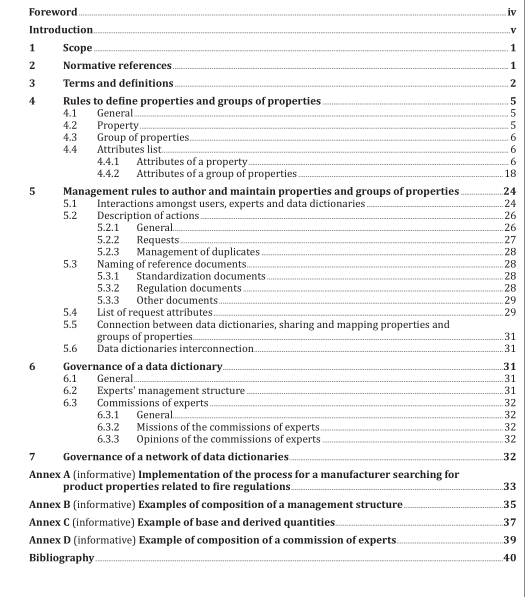ISO 23386:2020 pdf download.Building information modelling and other digital processes used in construction — Methodology to describe, author and maintain properties in interconnected data dictionaries
This document establishes the rules for defining properties used in construction and a methodology for authoring and maintaining them, for a confident and seamless digital share among stakeholders
following a BIM process.
Regarding the definition of properties and groups of properties, this document provides:
— definitions of properties and groups of properties as a list of attributes;
— definitions of all the provided attributes.
Regarding the authoring and maintaining process, this document provides:
— definitions and roles of applicants;
— definitions and roles of experts and the commission of experts;
— definitions of request’s attributes;
— definitions of expert’s attributes;
— requirements to establish the management rules to interconnect data dictionaries through the mapping process for properties and groups of properties.
To apply the methodology of this document, it is presupposed that the following are in place:
— an established governance model for a data dictionary;
— a framework for a network of data dictionaries.
It is not in the scope of this document to provide the content of the interconnected data dictionaries.
2 Normative references
The following documents are referred to in the text in such a way that some or all of their content constitutes requirements of this document. For dated references, only the edition cited applies. For undated references, the latest edition of the referenced document (including any amendments) applies.
ISO 639-1, Codes for the representation of names of languages — Part 1: Alpha-2 code
ISO 3166-1, Codes for the representation of names of countries and their subdivisions — Part 1: Country codes
ISO 3166-2, Codes for the representation of names of countries and their subdivisions — Part 2: Country subdivision code
ISO 4217, Codes for the representation of currencies
ISO 8601 (all parts), Date and time — Representations for information interchange
ISO/IEC 11404, Information technology — General-Purpose Datatypes (GPD)
4 Rules to define properties and groups of properties
4.1 General
To be non-ambiguous, machine-readable as well as human-understandable, properties and groups of properties shall be defined by a set of attributes. Some attributes are mandatory, and others are optional.
For a property to be human-understandable, any application following this document may be able to display the value of many attributes defining this property, for example name, name of the reference document, test method, unit, etc.
4.2 Property
A property shall be defined using the set of attributes as listed in Table 1
4.3 Group of properties
A group of properties shall be defined using the set of attributes as listed in Table 2.
Applicants can propose a group of properties as appropriate for their needs.
The different categories of a group of properties are (exhaustive list):
— alternative use;
— class;
— composed property;
— domain;
— reference document.
Groups of properties can be organised in tree structures. Any property attached to a group of properties is inherited by the sub-group(s) of properties.
Any property may be included in several groups of properties.
EXAMPLE
— class: Panel (class corresponding to a family of products in a classification);
— class: ifcWall;
— domain: Acoustic (domain corresponding to a scientific discipline), architecture, economy;
— composed property: “concrete facing quality” is a group of properties linking 3 properties (concrete planarity, concrete hue, concrete texture).
4.4 Attributes list
4.4.1 Attributes of a property
Table 1 provides an exhaustive list of attributes used to manage a property within a data dictionary.
Table 1 contains 8 columns:
— Code: code that can be used to identify the attribute;
— Name: name of the attribute;
— Description: description of the attribute, and how it shall be used;
— Example: some examples of possible values for the attribute;
— Interconnected data dictionaries management rule: rule that defines if it is mandatory or not to provide a value for the attribute. When “calculated” is noticed, this means that the value of the attribute is provided by the system managing a data dictionary, not by a user (i.e. when a request has been validated, the system shall change the property’s attribute “status” to “active”);
— Request form management rule: rule that defines if it is mandatory or not relevant to provide a value for the attribute in a request form to interact with the data dictionary;
— Type: datatype of the attribute;
— List of values: list of possible values for the attribute.ISO 23386 pdf download.ISO 23386 pdf download
